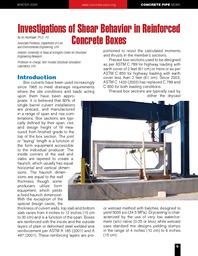
ATTENTION: The works hosted here are being migrated to a new repository that will consolidate resources, improve discoverability, and better show UTA's research impact on the global community. We will update authors as the migration progresses. Please see MavMatrix for more information.
Show simple item record
| dc.contributor.author | Abolmaali, Ali | |
| dc.date.accessioned | 2014-06-27T19:12:24Z | |
| dc.date.available | 2014-06-27T19:12:24Z | |
| dc.date.issued | 2008 | |
| dc.identifier.citation | Concrete Pipe News 60(1):9-12 | en_US |
| dc.identifier.issn | 0045-8015 | |
| dc.identifier.uri | http://hdl.handle.net/10106/24325 | |
| dc.description | This article is an abstract of the study entitled, “Experimental and
Finite Element Based Investigations of Shear Behavior in Reinforced
Concrete Box Culverts | en_US |
| dc.description.abstract | Box culverts have been used increasingly since 1965 to meet drainage requirements where the site conditions and loads acting upon them have been appropriate. It is believed that 80% of single barrel culvert installations are precast, and manufactured in a range of span and rise combinations. Box sections are typically defined by their span, rise, and design height of fill measured from finished grade to the top of the box section. The joint or “laying” length is a function of the form equipment accessible to the individual producer. The inside corners of the wall and slabs are tapered to create a haunch, which usually has equal horizontal and vertical dimensions. The haunch dimensions are equal to the wall thickness though some producers utilize form equipment, which yields a fixed haunch dimension. With the exception of the special design cases, the thickness of culvert walls, top slab and bottom slab varies from 4 inches to 12 inches (10 cm to 30 cm) and is a function of the span. Boxes are reinforced with the inside and the outside layers of plain or deformed steel welded wire reinforcement per ASTM A 185 (2001) and A 497 (2001). These reinforcing layers are proportioned to resist the calculated moments and thrusts in the member’s sections. Precast box sections used to be designed as per ASTM C 789 for highway loading with earth cover of 2 feet (61 cm) or more or as per ASTM C 850 for highway loading with earth cover less than 2 feet (61 cm). Since 2003, ASTM C 1433 (2003) has replaced C 789 and C 850 for both loading conditions. Precast box sections are typically cast by either the drycast or wetcast method with batches designed to yield 5000 psi (34.5 MPa). Drycasting is characterized by the use of very low water/cement (w/c) ratios (0.35 or less) while wetcast uses standard mix designs yielding slumps in the range of 4 inches (10 cm) to 6 inches (15 cm). | |
| dc.language.iso | en_US | en_US |
| dc.publisher | American Concrete Pipe Association | en_US |
| dc.subject | Reinforced concrete | en_US |
| dc.subject | Box culverts | en_US |
| dc.title | Investigations of shear behavior in reinforced concrete boxes | en_US |
| dc.type | Article | en_US |
| dc.publisher.department | Department of Civil and Environmental Engineeing, University of Texas at Arlington | |
| dc.identifier.externalLink | http://www.concrete-pipe.org/pdfcpn/2008-CP-News-Winter-printable.pdf | en_US |
| dc.identifier.externalLinkDescription | The original publication is available at the journal homepage | en_US |
Files in this item
- Name:
- 2008-CP-News-Winter-printable.pdf
- Size:
- 258.3Kb
- Format:
- PDF
- Description:
- PDF
This item appears in the following Collection(s)
Show simple item record


